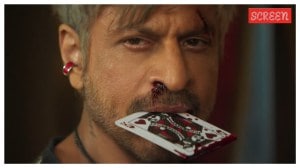We were told to kill,but never told why
Unlike most tribal youths in Orissa who joined the ranks of Maoists as a way out of poverty,Ghasiram Samutika alias Akash managed to stay away....
Unlike most tribal youths in Orissa who joined the ranks of Maoists as a way out of poverty,Ghasiram Samutika alias Akash managed to stay away. Akash,who belongs to a family of farmers,was one of eight children,growing up in the Gudari block of Rayagada district. It was much later that he got drawn to the Maoist movement. After eight tribals were killed in Mandrabaju in Gajapati district in December 1999,Akash joined a protest over it. There,he met the states top Naxal leader,Sabyasachi Panda,who was scouting for new recruits for Kui Lewang Sangh,a Naxal outfit. In January 2000,Akash joined Panda and gradually rose from being a member of the divisional committee to becoming the commander of Basdhara division,covering Kandhamal,Gajapati and Rayagada districts.
Akash was one of the few members in the state cadre to have handled almost all weapons in the Maoist armouryfrom the single-barrel muzzle loader to AK-47s. He was an expert at assembling landmines and could rattle off code words to alert fellow Maoists about policemen. But after nine years of living dangerously,Akash surrendered before the then Rayagada SP Ashis Kumar Singh in 2009.
He says he surrendered because he grew uncomfortable with Pandas leadership,the growing hegemony of Maoist leaders from Andhra Pradesh and the lack of accountability displayed by the leaders.
The first signs of difference between Panda and him surfaced when Panda ordered the killing of Daku Majhi,an independent candidate from Chandrapur during the 2004 assembly election. Akash says he also slowly grew disillusioned with the Maoists failure to help the repressed tribals.
I was against the indiscriminate killings of tribals on the excuse that they were informers. Though I respected the party,I understood that the tribals lot was not going to improve under the Maoists. We were just told to kill somebody but never explained why that person was to be killed, says Akash,31.
The relationship between Panda and Akash further soured when Azad alias Keshava Donagiri Rao,a Maoist from Srikakulam in Andhra Pradesh,replaced him as Pandas deputy.
For the Maoist leadership,the surrender of Akash was a loss since he was good at planning insurgency operations. From the Udaygiri jailbreak in 2006 in which the jailor was taken hostage and 40 prisoners freed,to the attack on the Nayagarh police armoury in February 2008,he had plotted everything meticulously. I did a recce of Nayagarh,dressed as a villager,several months before the actual attack. To hide my curly hair,I would tie a gamchha on my head, he says.
A year after quitting the Maoists,Akash now lives with his wife,also a former Naxal,and their two-year-old daughter. Following his surrender,he got
Rs 10,000 from the state government and gets a monthly allowance from the police. Hes yet to receive a loan of Rs 2 lakh that the government promised him and land.
Akash often thinks of his past. Those were tough days. Every morning,we would walk for four to six hours wearing boots. While armed sentries kept vigil outside the camp,we attended classes on Maoism. Dinner was served at 9 p.m. and everyone had to go to bed by 10 p.m. But its not that I hated that life. What I did not like was the lack of principles among Maoist leaders, says Akash. Now I tell tribals not to join the Maoists, he adds.
- 01
- 02
- 03
- 04
- 05





























